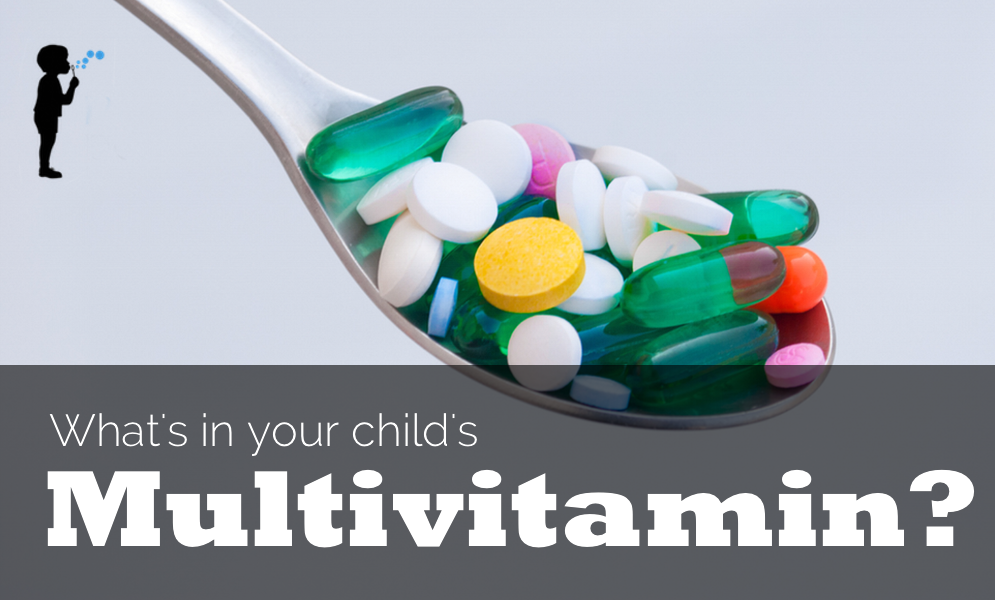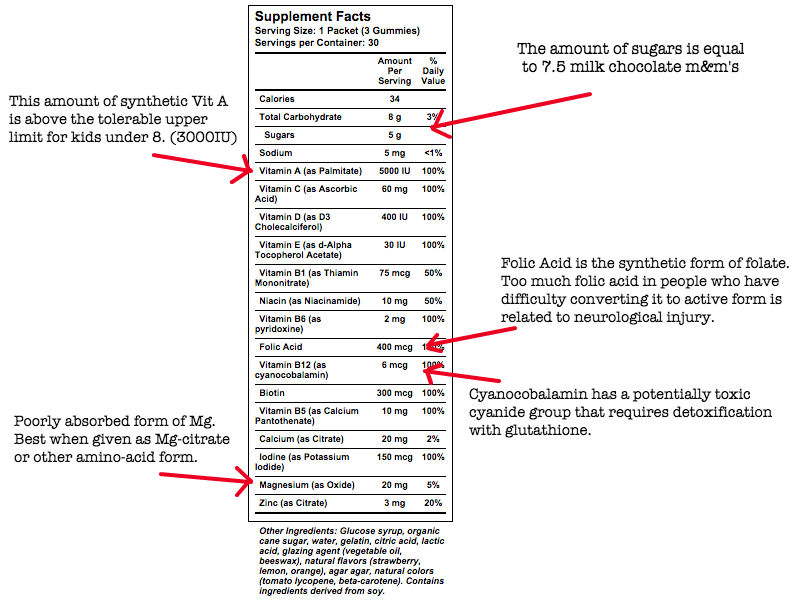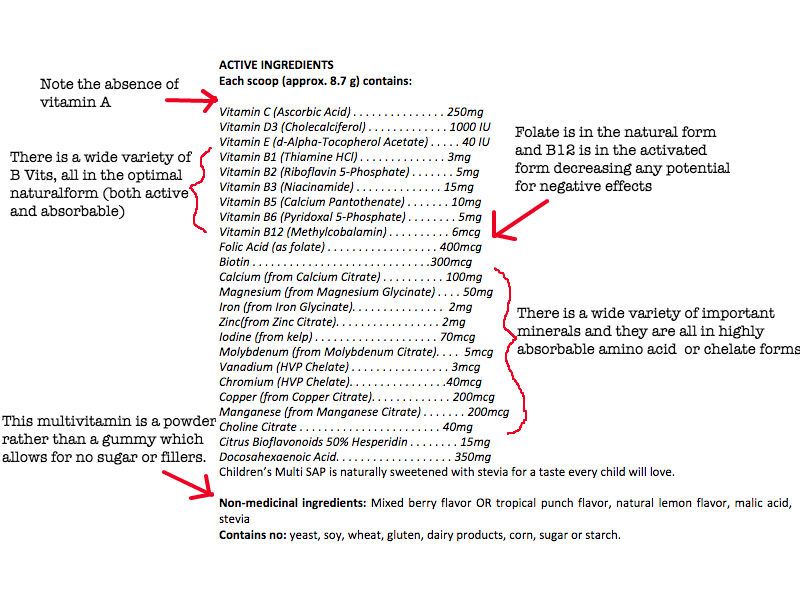
What’s In Your Child’s Multivitamin??
People take multivitamins because they are supposedly healthy. While I regularly prescribe vitamins and supplements for specific reasons, I do not recommend that everybody take a multivitamin. Moreover, I have been shocked at the poor quality of the ingredients in many children’s multivitamins. Children have such delicate, developing neurological systems that it is imperative that if you are giving them vitamins, they must be high quality.
Below is the ingredients list for a common multivitamin found at many natural food stores:
In case you want a little more information on the above mentioned vitamins:
- Vitamin A: There is no toxicity associated with the natural form of beta-carotene or mixed carotenoids. Retinyl palmitate is the synthetically made active form and may negatively affect bone density. Furthermore, Vitamin A toxicity associated with long-term elevated doses can lead to liver damage.
- Folate: Typically found in vitamins and fortified foods as the synthetic form Folic Acid. The safe upper limit of folic acid in children 4-8 is 400 mcg daily. Most children’s vitamins contain 400mcg of folic acid so if your child is eating many fortified foods, then he or she may be getting more than the recommended amount of synthetic folic acid. Folate, which is found in food sources, has no “upper limit.” Also, there are as many as 14% of Caucasian people and 21% of Hispanic people who have a gene mutation that does not allow them to convert Folate to the active Methyl-Folate (known as an MTHFR mutation). In these people, it is important to only give vitamins with Methyl-Folate and not the synthetic Folic Acid. Ask your physician about testing for this gene mutation.
- Vitamin B12: Typically found in supplements as the inactive form Cyanocobalamin, which is the Cobalamin (Vit B12) joined to a cyanide group. Cyanide is a poisonous substance that rarely causes toxicity when given with B12. However, it could possibly cause problems if the person does not have sufficient amounts of the antioxidant glutathione, which is responsible for metabolizing the cyanide group. Only 1% of Cyanocobalamin converts to the active form of B12. Hydroxycobolamin is another inactive form of B12 that has no toxicity associated with it. Methylcobalamin is the active form of Vitamin B12 and is significantly more bioavailable. It has no toxicity associated with it, however over-supplementing with Methylcobalamin may decrease your body’s own natural production.
Now, here is the ingredients list for a high-quality, physician-grade multivitamin:
The physician grade vitamin is admittedly a lot more expensive than the retail brand and I know this can be cost prohibitive for long-term use. I like to follow the age-old wisdom:
“There is no replacement for healthy food.”
Ensure that your child is getting adequate nutrients from high-quality, healthy food rich in fresh fruits and vegetables. If you have an excessively picky eater or other health concern, a multivitamin might be a good idea. Talk with your naturopathic physician about which vitamin might be the right fit for you.
For more information about multivitamins, including multivitamin recommendations see Skip the Centrum! (A Guide to a Good Multivitamin)
References:
- http://centraldrugsrx.com/doctorblog/comments/brief-comparison-of-the-three-formulations-of-vitamin-b12
- http://holisticprimarycare.net/topics/topics-a-g/functional-medicine/1353-mthfr-mutation-a-missing-piece-in-the-chronic-disease-puzzle
- http://lpi.oregonstate.edu/mic/vitamins




JM
April 11, 2017 at 3:28 amPlease, I would also like the name of the multivitamin for the label shown. I have looked for a vitamin like this for my child and I am not finding anything.
JM
April 15, 2017 at 3:41 pmI received notification by email of a new comment to this thread but it isn’t here when I click on the link. It was in reply to a comment that also is not showing up on this page and from the small sample I could read in the email looked like it might answer the question of what vitamin label was used in the article.
Rachel Atkinson
February 6, 2017 at 3:25 amHi! This is so helpful! Thank you! What’s the name of the physician-grade multivitamin? My child needs this.
Stephanie Spencer
January 18, 2017 at 2:59 amExactly my question! Please give names of specific children’s vitamins we should get. Which brand(s) for toddlers under age 3, and for older children etc…
Stephanie Strudley
December 12, 2016 at 4:44 amThis is very helpful but I can’t find a children’s vitamin that resembles the vitamin/mineral content in this article! What brand is used here?